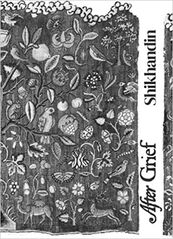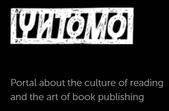“Death is a rusty truck / bulldozing in to trash / the morning,” begins Shikandin’s After Grief, which is an exploration of death, loss, separation from family, and finding light.
Most of the poems, some of which are autobiographical, offers us the poet’s introspection of the threshold between life and death, glimpsing that which is veiled. Through a rich tapestry of images, she allows us moments of rapture. Interestingly, the tapestried cover, repeated as sectional divides, matches the rich imagery of the poems. Natural landscapes, seascapes, domestic scenes populate the settings of the poems and offer imagery spanning the physical and the metaphysical. Shikandin teaches us the many hues of grief. I love the ending of “Unwanted,” where grief is concretized; we hold grief close, experiencing it fully, its softness and jaggedness, as we read: “hold it close — this juddering / of ribs. This folding of shoulders. These / unblinking eyes that defy the saturation of clouds.” Some endings of poems heart-stoppers, such as, “your hands / even time’s wheel would turn into clay.”
“Dawning” begins with evocative opening line. “No rain yet, and the sky is a beggar’s quilt.” The poem describes daily scenes, making mundane objects extraordinary, such as, “A water-colored plastic bag floats up like an airborne jellyfish.” In “Crossing,” “The season slides off your shoulder. A tidy pile / of days.” Surprising juxtapositions and images make the poet’s experience of loss and her description of the ebbing of life both realistic and endearing. In “Dawning,” the first stanza is a street scene; we don’t expect the second stanza which is about the poet’s father-in-law lying on a hospital bed gradually fading away. The nature of the ebbing of life contrasting with the prevalence of nature is a motif throughout the volume.
The final stanza of “Hope springs like grass from ashes,” with its resonance of the proverbial “hope springs eternal,” with its many-hued images of light—lanterns, lamps, blossoms as fallen stars—the mystic night arrayed with the song of a bird, the silhouettes making objects into “vaporous silhouettes” offer us the richness of British romantic poetry and the tradition of regional Indian poets. Shikandin is able to give these influences her own twist with her attention to the free verse form that flows through the use of sound patterns and interesting line breaks. She uses geographic and cosmic imagery to portray the sound of laughter as the ultimate sound connecting us to the spirit. Images concretize abstract nouns. For example, spirit visually described as “fluff of life upon my shoulder,” fluff making us imagine our own associations—cotton, cloud or bird. Or in “After the “Passing of Father,” “your tired hands swat / At another intruding memory bouncing on that net / Of emptiness,” offers us both a mundane gesture as well as memory as pestilence.
In “The way I imagine you” we hear the speaker’s grief in having a mother who is beyond reach in her mansion; only her death brings relief to the speaker: “I have no reason to mourn, anymore.” The experience of disconnection with the mother strikes a strident note in this volume. The most extraordinary poem on this theme is “The Fist,” which contrasts strikingly with the poet’s deep love for the father figure who connects with her despite death. “I am the fist that slammed out through your vagina. / I am the stone that shattered your lying mirror./ You hated me for breaking / your faith. Mothers don’t seek / daughters, and here you were saddled / with two.” Thus begins “The Fist,” drawing us into the drama of disconnection imaged in the description of the mother’s experience of the shock of arrival of the girl child. The symbol of the fist is both a symbol of rebellion as well as a container.
Shikandin’s poems entrance us with its musical quality. Internal rhymes, assonance and consonance flow readily from her pen. Witness her use of sonics in internal rhymes, slant rhymes, and assonance surprising us, as in “Hope Springs Like Grass from Ashes,” “lawn,” “thorn,” “song” placed in close range within two lines. Sound patterns, enjambed lines, alternating stops and pauses in the middle of lines make Shikandin’s poems limpid in their flow.
Although some poems such as “Dear Emily” and “Cancer Ward” are wordy and need editing, and some poems push to the brink of overwriting and prosaic declarations, the volume anchors us in the physicality of experience. I think this is the uniqueness of Shikandin’s poetry, which shows how much we can delve into experiences within and without through language and poetic craft.
Most of the poems, some of which are autobiographical, offers us the poet’s introspection of the threshold between life and death, glimpsing that which is veiled. Through a rich tapestry of images, she allows us moments of rapture. Interestingly, the tapestried cover, repeated as sectional divides, matches the rich imagery of the poems. Natural landscapes, seascapes, domestic scenes populate the settings of the poems and offer imagery spanning the physical and the metaphysical. Shikandin teaches us the many hues of grief. I love the ending of “Unwanted,” where grief is concretized; we hold grief close, experiencing it fully, its softness and jaggedness, as we read: “hold it close — this juddering / of ribs. This folding of shoulders. These / unblinking eyes that defy the saturation of clouds.” Some endings of poems heart-stoppers, such as, “your hands / even time’s wheel would turn into clay.”
“Dawning” begins with evocative opening line. “No rain yet, and the sky is a beggar’s quilt.” The poem describes daily scenes, making mundane objects extraordinary, such as, “A water-colored plastic bag floats up like an airborne jellyfish.” In “Crossing,” “The season slides off your shoulder. A tidy pile / of days.” Surprising juxtapositions and images make the poet’s experience of loss and her description of the ebbing of life both realistic and endearing. In “Dawning,” the first stanza is a street scene; we don’t expect the second stanza which is about the poet’s father-in-law lying on a hospital bed gradually fading away. The nature of the ebbing of life contrasting with the prevalence of nature is a motif throughout the volume.
The final stanza of “Hope springs like grass from ashes,” with its resonance of the proverbial “hope springs eternal,” with its many-hued images of light—lanterns, lamps, blossoms as fallen stars—the mystic night arrayed with the song of a bird, the silhouettes making objects into “vaporous silhouettes” offer us the richness of British romantic poetry and the tradition of regional Indian poets. Shikandin is able to give these influences her own twist with her attention to the free verse form that flows through the use of sound patterns and interesting line breaks. She uses geographic and cosmic imagery to portray the sound of laughter as the ultimate sound connecting us to the spirit. Images concretize abstract nouns. For example, spirit visually described as “fluff of life upon my shoulder,” fluff making us imagine our own associations—cotton, cloud or bird. Or in “After the “Passing of Father,” “your tired hands swat / At another intruding memory bouncing on that net / Of emptiness,” offers us both a mundane gesture as well as memory as pestilence.
In “The way I imagine you” we hear the speaker’s grief in having a mother who is beyond reach in her mansion; only her death brings relief to the speaker: “I have no reason to mourn, anymore.” The experience of disconnection with the mother strikes a strident note in this volume. The most extraordinary poem on this theme is “The Fist,” which contrasts strikingly with the poet’s deep love for the father figure who connects with her despite death. “I am the fist that slammed out through your vagina. / I am the stone that shattered your lying mirror./ You hated me for breaking / your faith. Mothers don’t seek / daughters, and here you were saddled / with two.” Thus begins “The Fist,” drawing us into the drama of disconnection imaged in the description of the mother’s experience of the shock of arrival of the girl child. The symbol of the fist is both a symbol of rebellion as well as a container.
Shikandin’s poems entrance us with its musical quality. Internal rhymes, assonance and consonance flow readily from her pen. Witness her use of sonics in internal rhymes, slant rhymes, and assonance surprising us, as in “Hope Springs Like Grass from Ashes,” “lawn,” “thorn,” “song” placed in close range within two lines. Sound patterns, enjambed lines, alternating stops and pauses in the middle of lines make Shikandin’s poems limpid in their flow.
Although some poems such as “Dear Emily” and “Cancer Ward” are wordy and need editing, and some poems push to the brink of overwriting and prosaic declarations, the volume anchors us in the physicality of experience. I think this is the uniqueness of Shikandin’s poetry, which shows how much we can delve into experiences within and without through language and poetic craft.





